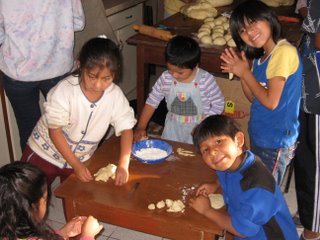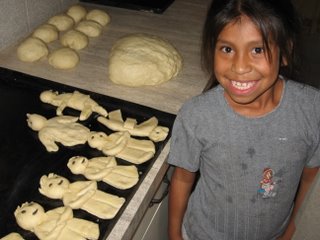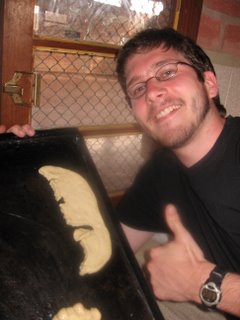As I rapidly approach the completion of my first month here in Bolivia, I thought that it might be appropriate to comment on some of the occurrences to which I have become accustomed. So, here is a list of sixteen aspects of Cochabamban life that have drawn my attention:
1.
Receiving inquisitive stares from passengers while riding the public transporation system. Upon boarding a bus, I notice that many Cochabambans will fix their attention on the novelty that is the gringo. Aside from the fact that I am clearly not from Bolivia, when I choose to carry on a conversation in Spanish with a fellow passenger, especially if it concerns life in the U.S., I will surely receive many interested ears. Comically, most of the time these inquisitive listeners will act like they could care less, and then hurredly look away when we make eye contact.
2.
Walking on unpaved, rock-filled roads. The vast majority of the streets in Cochabamba are unpaved, and at first it can be quite a challenge to navigate the uneven terrain. However, after continuously tredding upon these obstacles, I no longer have the constant fear of falling flat on my face. In fact, when I feel particularly bold, I will even attempt to read during my daily treks.
3.
Avoiding stray dogs or carrying a rock to threaten them. The quantity of roaming canines in the city is appalling, and the probability of crossing paths with one who does not take kindly to strangers is quite high. Thus, it is best to carry at least one stone (two or three if you see a pack of dogs approaching) in hand if you suspect that you might have such an encounter. The old cliché ´´It´s not the size of the dog in the fight but the size of the fight in the dog´´ has particular relevance here. More than once, a small mutt unexpedectly has challenged my bravado, forcing me to use a warning shot (stone) to ward him off.
4.
Passing by half-built buildings. Many architectural projects in Cochabamba have become victims of the economic hardship in this country. The ´´guts´´ of these structures are exposed for all to see, a sad ending to numerous well-intentioned projects that could not acquire the funds necessary to finish the job. Perhaps this dilemma also reflects notoriously poor-planning in Bolivian public projects. Frequently initiatives are begun without securing the necessary funds to see the project through to its completion.
5.
Taxis honking at you even when you show no interest. If you are waiting on a street corner, whether it be to cross the road or to board one of the myriad ´´micros,´´ you can be sure that more than one taxi will honk to draw your attention. I am not sure if they believe you will be persuaded to board their autos by a persistent beeping sound, or if they merely want you to check out their uniformly-white vehicles. Either way, this act seems to be accentuated by the presence of a gringo waiting on the curb.
6.
Never having the right-of-way. It is rumored that Cochabamban driving laws bestow many privileges to pedestrians, but if you assume that these mandates will be followed, you will probably pay for it. Cochabamban drivers, particularly those conducting taxis, take their dominance of the road quite seriously. You will be lucky if they halt at the absurdly few traffic lights. All of this is to say that crossing intersections in the city is an interesting game of Human Frogger (Costanza).
7.
Not being able to drink the tap water. Filled with bacteria that will wreak havoc on your digestive system, the Cochabamban drinking water is not fit for outsiders. For this reason, it is always necessary to carry around a bottle of purified water, which may distinguish you as a foreigner, but is certainly more desirable than the effects brought on by invasive parasites.
8.
Taking freezing cold or scalding hot showers. To be honest, it is usually a mix of both. However, there is no happy medium with the electrically-heated showerheads in Cochabamba. Finding a comfortable bathing temperature is a talent I have not yet mastered.
9.
Seeing extremely-poor indigenous women with their infant children walking the same streets as businessmen in three-piece suits approaching their Ford Expeditions. The disparity between rich and poor is hugely accented in Bolivia. Whereas the middle-class in the U.S. comprises a large portion of the population, here it is almost non-existent. The vast majority of the poor in this country are indigenous, and the disdain that the privileged elite have for them is readily observable in public, both in buses and on the streets.
10.
Littering. Not only is it culturally-accepted, but it is also prevalent throughout the city. The streets are covered with all kinds of plastic bags, tissues, dirty socks, wrappers, and worn shoes. You can throw just about anything in the streets (a custom I do not personally partake in), but it you happen to spit on the ground in the presence of others, you most certainly will receive dirty looks. I have not totally figured out this behavior, because, on several occasions, I have witnessed well-dressed, grown men relieving themselves on street corners. However, the scarcity of trashcans may be partly responsible for the unfortunate tendency of Cochabambinos to dispose of their waste in any convenient locatoin. In addition, there is no recycling system apart from the two-liter bottles of Coke you buy from street vendors who require an empty bottle in return for your purchase.
11.
Bargaining for everything. It is not rude if done with the proper respect and is certainly necessary for a gringo. Prices for foreigners are at least twice as much, particularly when inquiring about a taxi ride. It is imperative that you and the driver agree on a price before entering the taxi, and even if, upon arriving at your destination, he (all taxi drivers are men) tells you that the distance was much greater than expected and demands a higher rate, you must be resolute and direct in your willingness to pay only the original amount.
12.
The slow pace of life. For example, if you agree to meet a Bolivian at 2:00 p.m., it is probable that he or she will not arrive until 3:00 or 4:00 p.m. Tardiness is not considered rude and is extremely prevalent amongst the locals. Movies and Sunday masses are about the only social events at which punctuality is necessary. Everything else mandates a late arrival.
13.
Being lost. You are lucky to find street names listed on the corners of most blocks. Those that have them are located almost exclusively in the center of town. If you want to know where you are, the best option is to ask someone who looks like they might live nearby. However, many times they will tell you it is ´´una calle innominada,`` a nameless street.
14.
Walking a lot. Especially on Saturday afternoons in the center of town, it is much faster to walk than to take the uncomfortably crowded and slow ´´micros´´ (buses). If you are headed to the huge open-air market known as La Cancha during this time, you will also compete with a great deal of foot traffic. Speaking of La Cancha, this truly is the place to search for everything your heart desires. You literally can find
anything you want here, from high-end electronics to llama fetuses (good luck charms when buried under the cornerstone of a newly-built house). For this reason, I now call the Internet the CyberCancha. In addition, La Cancha offers quality products for much lower prices than traditional stores. Why is this so? Nearly all of the goods are contraband in one form or another, which means that they do not come with a receipt or the option of making a return. Thus, it is absolutely necessary to test the functionality of a product before taking it with you.
15.
Passing by houses with glass shards that line the outer walls. House robberies are common enough that even the most modest houses have this low-cost crime deterrent. However, after seeing quite a few abodes with this security system, I am convinced that even a mediocre thief could circumvent the sharp obstacles. Guard dogs are a different story. On several occasions, I have nearly been bitten by canines who felt that I was walking a little too close to their territory. It is best simply to run from these dogs, as they are not easily threatened by stones. Eventually, they will stop chasing you. And in the case that a dog jumps on but does not bite you in the presence of its owner, do not expect an apology. In my experience, they will blame you for getting too close.
16.
Children begging for money to buy school supplies. When walking in the main plazas of Cochabamba, it is not uncommon for children dressed in shabby clothing to approach you with a list of school supplies and ask for help with the purchases. These are not scams to take advantage of sympathetic tourists. After having several conversations with such children, I have learned that some live with distant relatives hours outside of the city, go to school a couple of times per week, and have to work in the streets the rest of the time. A typical job for these young children (aroud eight-years-old) is shoe shining. They will offer you their services even if you are wearing tennis shoes. But instead of shunning their advances and continuing on my way, I have learned that it can be worthwhile to sit on a bench with them and share a small snack or Coke. They are usually quite hungry and inquisitive about life in the States.
And thus concludes a highlight of some of my experiences in Cochabamba, the breadbasket of Bolivia. With its many interesting wrinkles and personalities, this city provides lasting memories for its visitors. Life here is anything but mundane, and the possibility of the unexpected is part of the charming adventure.



